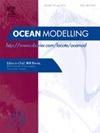Accuracy assessment of recent global ocean tide models in coastal waters of the European North West Shelf
IF 3.1
3区 地球科学
Q2 METEOROLOGY & ATMOSPHERIC SCIENCES
引用次数: 0
Abstract
The accuracy of global ocean tide models is assessed in coastal waters of the European North West Shelf to ascertain where higher resolution local (forecast) models are most needed for geophysical and navigational applications, and which global models are most suitable for providing boundary conditions for regional and local tide models. Five recent global ocean tide models (FES2014b, EOT20, TPXO9-atlas-v5, GOT4.10c, and DTU16) are considered, with the models first compared by interpolating them onto common grids and computing the mean absolute deviation at each grid point. Coastline tide gauge and offshore bottom pressure sensor data were collated from several sources to give a total of 279 observation sites for evaluating model accuracy, including observational values from 137 locations that have not previously been released and have therefore not been assimilated into any of the global models tested. The residual errors between each model’s predicted phasor and the corresponding observed phasor were calculated at each observation location, and quantified using the root mean square (RMS) and median absolute residual (MAR) for the eight tidal constituents M2, S2, N2, O1, K1, K2, P1, and Q1. To avoid RMS values being biased by observation point density, a Voronoi-weighted RMS based on the water area of the Voronoi polygon about each observation location was also developed and used. Four zones were defined based on ocean depth to gauge model performance, and model inaccuracy is again demonstrated in near-shore regions. Seven further zones were defined based on geographical areas, which reveals inhomogeneity among the global models. The smallest overall root sum square (RSS) RMS error across all eight constituents arises with FES2014b, although TPXO9-atlas-v5 has the best performance when using the MAR and Voronoi-weighted RMS metrics. Using only the 137 observation sites that have not been assimilated by any model and therefore provide an independent accuracy assessment, FES2014b exhibits the smallest errors at the coastline, with an RSS RMS of 24.46 cm. All models exhibit larger errors with the 137 independent observation sites than with all 279 observation sites, with an average overall increase in RSS RMS error of 12%, and an increase of 30% for coastline tide gauges, highlighting the need for local model development in these areas.
欧洲西北大陆架沿岸水域近期全球海洋潮汐模型的精度评估
在欧洲西北大陆架沿岸水域评估了全球海洋潮汐模式的精度,以确定在哪些地方最需要更 高分辨率的本地(预报)模式来进行地球物理和导航应用,以及哪些全球模式最适合为区域和 本地潮汐模式提供边界条件。研究考虑了五个最新的全球海洋潮汐模式(FES2014b、EOT20、TPXO9-atlas-v5、GOT4.10c 和 DTU16),首先将这些模式插值到共同网格上,然后计算每个网格点的平均绝对偏差,以此进行比较。海岸线验潮仪和近海底压传感器数据来自多个来源,共 279 个观测点,用于评估模式的准确性,其中包括 137 个地点的观测值,这些观测值以前没有发布过,因此没有被同化到任何测试的全球模式中。每个观测点都计算了每个模式的预测相位与相应观测相位之间的残差,并使用均方根(RMS)和绝对残差中值(MAR)对 M2、S2、N2、O1、K1、K2、P1 和 Q1 这八个潮汐成分进行量化。为避免均方根值受观测点密度的影响,还根据每个观测点的沃罗诺多边形的水域面积开发并使用了沃罗诺加权均方根值。根据海洋深度定义了四个区域以衡量模型性能,在近海区域再次证明了模型的不准确性。根据地理区域又定义了七个区域,这显示了全球模式之间的不均匀性。虽然 TPXO9-atlas-v5 在使用 MAR 和 Voronoi-weighted RMS 指标时性能最佳,但 FES2014b 在所有八个成分中的总均方根误差最小。FES2014b 仅使用未被任何模式同化的 137 个观测点,因此可提供独立的精度评估,其海岸线误差最小,RSS 均方根误差为 24.46 厘米。与全部 279 个观测站点相比,所有模式与 137 个独立观测站点的误差都较大,RSS 均方根误差总体平均增加了 12%,海岸线验潮仪的误差增加了 30%,这凸显了在这些地区开发本地模式的必要性。
本文章由计算机程序翻译,如有差异,请以英文原文为准。
求助全文
约1分钟内获得全文
求助全文
来源期刊

Ocean Modelling
地学-海洋学
CiteScore
5.50
自引率
9.40%
发文量
86
审稿时长
19.6 weeks
期刊介绍:
The main objective of Ocean Modelling is to provide rapid communication between those interested in ocean modelling, whether through direct observation, or through analytical, numerical or laboratory models, and including interactions between physical and biogeochemical or biological phenomena. Because of the intimate links between ocean and atmosphere, involvement of scientists interested in influences of either medium on the other is welcome. The journal has a wide scope and includes ocean-atmosphere interaction in various forms as well as pure ocean results. In addition to primary peer-reviewed papers, the journal provides review papers, preliminary communications, and discussions.
 求助内容:
求助内容: 应助结果提醒方式:
应助结果提醒方式:


